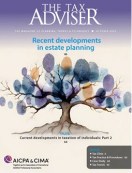- column
- TAX PRACTICE MANAGEMENT
Leadership in tax practice: Inspiring teams and driving growth amid industry change
Amid turbulence in the tax profession, firm leaders can impart clarity, empathy, and inspiration to inculcate lasting loyalty and success.
Related
Government withdraws defense of retirement fiduciary rule
Practitioner engagement letters: Strategies for increasing compliance
Preparer’s intent to evade tax extends taxpayer’s limitation period
Editor: April Walker, CPA, CGMA
Navigating the crossroads of change
The tax profession is standing at a critical inflection point. With sweeping changes on the horizon, including major new tax legislation, evolving IRS priorities, emerging technology such as artificial intelligence, and generational shifts in the workforce, leaders in the accounting profession are being asked to step up in unprecedented ways. These are not just operational adjustments. They require fundamental shifts in how we lead.
For many firms, the challenge is no longer about whether we can technically perform the work. It is about how we lead people through uncertainty, inspire teams to do their best work, and create a culture where innovation and growth can thrive. Whether you are leading a solo practice, a midsize regional firm, or a multi–office national tax group, leadership today is more dynamic, more personal, and more essential than ever.
This column explores the evolving nature of leadership in tax practice, how to lead with clarity, how to inspire your team through complexity, and how to drive growth in a profession experiencing seismic change.
Today’s leadership imperatives: The skills that matter now
Historically, leadership in public accounting was often equated with being the smartest person in the room, the one with the deepest Internal Revenue Code knowledge or the most clients. While technical credibility still matters, it is no longer enough. Today’s leadership model is about how you connect with others, cultivate culture, and lead by example.
Emotional intelligence (EQ) has emerged as a differentiator among effective leaders. It means being attuned to your team’s needs, recognizing burnout before it becomes turnover, and knowing how to communicate difficult truths with empathy. Especially in the post–pandemic hybrid work environment, leaders must be intentional about staying visible and accessible, making space for both structured check–ins and informal connection.
Modern tax leaders are also learning to let go of perfectionism and embrace agility. With compressed deadlines, evolving legislation, and capacity challenges, it is no longer realistic — or healthy — for leaders to try to do it all. Delegation, trust, and empowerment are no longer “nice–to–haves“; they are required.
Equally important is purpose–driven leadership. Today’s professionals, particularly the younger generations, want more than a paycheck. They want to work for organizations that reflect their values, places where they can make a difference, not just meet a deadline. Leaders who tie firm goals to a greater purpose — whether supporting small businesses, helping families build wealth, or fostering community development — will find stronger loyalty and deeper engagement from their teams.
Leading through disruption: Turning uncertainty into opportunity
The tax landscape has always been dynamic, but the pace and volume of change in recent years have been staggering. Legislative overhauls, pandemic–era tax relief, shifts in client expectations, and talent shortages have created both chaos and opportunity. The question is not whether change is coming; it is whether we will be ready for it.
Great leaders do not wait for clarity. They lead with conviction in ambiguity. They recognize when it is time to pivot and rally their teams around a new direction. For instance, many firms that relied heavily on compliance revenue recognized early that this model was at risk. As tax preparation became increasingly commoditized, forward–thinking leaders moved to repackage their services with an advisory–first mindset, helping clients make better financial decisions, not just preparing returns.
At the same time, these leaders looked inward and modernized how work gets done. Process automation, document management systems, and client portals were once “future investments.” Now, they are the backbone of efficient, modern practices. Leaders who championed technology adoption, training, and workflow redesign have positioned their firms for speed, scalability, and flexibility.
Another strategy has been embracing nontraditional staffing models. Leaders are increasingly tapping into remote talent pools, fractional professionals, and global teams. These models not only expand capacity but allow firms to stay nimble, especially during busy season.
And importantly, transparency and communication are critical in disruptive times. When people do not know what is going on, they fill in the blanks, often negatively. Leaders who communicate frequently, explain the “why” behind decisions, and involve team members in the conversation build more resilient, invested teams.
Developing and empowering the next generation
Talent development is no longer the domain of HR; it is a leadership imperative. With Baby Boomers retiring and Millennials and Gen Zs stepping into critical roles, the future of the profession hinges on how well we develop our people.
One of the most overlooked leadership responsibilities is sponsorship — not just teaching junior team members how to prepare a return but advocating for their growth, exposing them to new opportunities, and giving them a seat at the table before they think they are ready. It is about helping others see their potential and giving them room to rise.
Formal mentorship programs are a good start, but high–performing firms go beyond that. They create learning cultures where it is OK to ask questions, try new things, and learn from mistakes. They encourage curiosity, cross–training, and creative problem–solving.
Empowerment also means letting go. Many seasoned professionals struggle to delegate because they are worried the work will not be done “their way.” But growth requires risk and trust. Empowered teams are more confident, more agile, and more motivated. They bring new ideas, challenge outdated assumptions, and elevate firm performance in unexpected ways.
Leadership development is also about succession planning. Who is ready to step up when you step out? Building leadership pipelines is not just a nice gesture; it is how firms survive transitions, retain clients, and protect institutional knowledge. Leaders must identify high–potential talent, offer targeted development, and create clear paths to advancement.
Visionary leadership drives growth
Growth does not happen by accident. It is the result of clear vision, disciplined execution, and a team that believes in the mission. Visionary leadership starts with understanding where the market is going and positioning the firm to meet clients where they will be, not just where they are now.
For some, that has meant launching industry–focused niches, such as construction, health care, or manufacturing, where the firm can become a true specialist. Others have leaned into wealth management, personal financial planning, international tax, or ESG (environmental, social, and governance) advisory services. This is a way of capitalizing on emerging needs and demonstrating their ability to deliver more than just returns.
Visionary leaders also challenge their firms to reimagine client service. That includes such efforts as:
- Deepening client relationships by reaching out more often and asking more questions;
- Offering subscription-based pricing models to create predictable value;
- Developing client education content, including webinars and white papers that build credibility; and
- Investing in client experience technology to enhance communication and transparency.
Leaders who tie their growth strategy to client needs, not just revenue goals, earn deeper trust and loyalty. Clients today want responsiveness, insight, and a partner who proactively anticipates issues. The firms that deliver on that promise are the ones that grow, through referrals, retention, and reputation.
Leadership that builds legacy
The most impactful leaders leave more than full calendars; they leave a mark. They build something sustainable. Something meaningful. They leave a legacy.
Legacy leadership is not about being irreplaceable. It is about ensuring the organization is stronger because of your presence and ready to thrive in your absence. That means documenting processes, coaching successors, and elevating others at every step.
It also means embodying the values you want to see in your firm. Respect, humility, integrity, curiosity, and service — these are not soft skills; they are culture pillars. When leaders model those values consistently, they become woven into the firm’s DNA.
Another aspect of legacy building is advocating for the profession itself. That may mean mentoring young CPAs, speaking at conferences, volunteering for professional organizations, or participating in policy discussions that shape the future of tax. Leaders who look beyond their firm to the broader ecosystem help keep the profession strong, vibrant, and respected.
At the end of the day, your leadership is measured not just by your billing rate or client roster but by how many people you lifted, mentored, and inspired along the way.
The future is now — and it needs you
Leadership in tax practice is not about waiting for perfect conditions. It is about leading through complexity, inspiring others through your example, and helping your firm adapt and thrive no matter what comes next.
As tax professionals, we are entering an era defined by uncertainty but also by incredible possibility. Firms that embrace this change, led by those willing to challenge assumptions, reimagine the path forward, and develop others, will not only survive but lead the way.
Whether you are a managing partner, a tax director, or an up–and–coming senior, your leadership matters. Right now. In how you show up. In how you invest in your team. And in how you shape the future of your firm and the profession.
So step up. Lead with heart. Inspire those around you.
Because the tax world is changing fast, and strong, visionary leadership has never been more essential.
Contributors
Mark Gallegos, CPA, MST, is a partner with Porte Brown Accountants & Advisers in Elgin, Ill., and April Walker, CPA, CGMA, is lead manager—Tax Practice & Ethics, Public Accounting for the Association of International Certified Professional Accountants. Gallegos is a member, and Walker is staff liaison, of the AICPA Tax Practice Management Committee. For more information about this column, contact thetaxadviser@aicpa.org.














